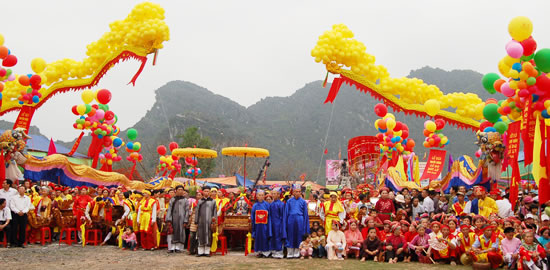
According to statistics from the Department of Grassroots Culture (Ministry of Culture, Sports and Tourism), there are up to 7,966 festivals held each year in the country, including 7,039 folk festivals, 544 religious festivals, and 322 revolutionary history festivals.
On average, Vietnam has about 21 festivals a day.
Participating in festivals means people are not at work. So with 21 festivals a day, tens of thousands of Vietnamese people are off work. A large number of working hours are used for improper purposes.
For example, the opening day of the Huong Pagoda Festival 2015 attracted 6,000 participants, although it was the first working day after the Lunar New Year (Tet) festival. The same day, Bai Dinh Pagoda Festival in Ninh Binh province also opened, with the participation of thousands of people. Thousands of people flocked to the Lim Festival in Bac Ninh though it was a working day.
Therefore, it is not difficult to explain the quiet scene at industrial parks after Tet because many workers stayed home to attend festivals. Many bosses had problems after Tet because their workers were busy at festivals until the end of the first lunar month. Offices were also quiet after Tet because employees were busy with spring festivals.
In Vietnam, festivals mainly take place in the Spring and the Fall, the season of farmers’ leisure after harvest. The long tradition of agricultural production is still maintained in the 21st century even though Vietnam is determined to become an industrialized country by 2020.
Labor productivity
Malte Luebker, senior expert of the International Labour Organization in Asia-Pacific, once explained, "Labor productivity of a country is almost impossible to reflect the level of diligence and ability of employees of that country.” But it seems to have close relations between the habit of festivities during leisure time after harvest time and labor productivity. Labor productivity of Vietnam is the lowest in the region.
Nearly 8,000 festivals were formed from agricultural production practice and they have all been maintained.
With a high proportion of laborers working in the agricultural sector, the labor productivity is low.
Malte Luebker confirmed, in Cambodia, Laos and Vietnam, there is still a large part of labor force employed in agriculture, so the overall labor productivity is lower than other countries in the region.
Similarly, countries with many workers in the informal economy, in which workers often do not have access to the latest or modern technology, have low overall productivity.
Although it does not reflect the diligence of worker, it is clear that low labor productivity is also a result of the habit of having many festive activities, along with poor labor discipline.
A sense of responsibility and reliability are the skills that most Vietnamese workers lack, according to a survey of the shortage of labor skills in foreign-invested enterprises released by the Institute of Labour and Social Science in 2014.
Labor productivity does not reflect the expertise level of workers, but obviously labor productivity will not be high when the human resources of a country are poor, especially if staff are not responsible, and are unreliable and not punctual, which are all needed in an industrial society.
The International Labour Organization (ILO) said that, at a broader level, labor productivity reflects the economic structure of a country. Recent reports of the ILO and the Asian Development Bank (ADB) show that labor productivity in manufacturing and service sectors is much higher than agriculture. Thus, with nearly 70% of the population still engaged in agriculture and the effects of seasonal agriculture still strong on the spiritual life of people, with nearly 8,000 festivals a year, it would be hard to dream of a quickly improving labor productivity.
According to the General Statistics Office, labor productivity in 2014 of Vietnam is nearly 15 times lower than that of Singapore, 11 times lower than Japan and 10 times lower than South Korea. Compared to neighboring countries, it is one-fifth of Malaysia and two-fifths of Thailand.

Leave your comment on this story